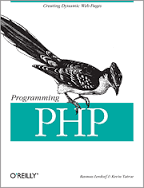📘 قراءة كتاب Programming PHP أونلاين


v
Table of Contents
Preface
. . . . . . . . . . . . . . . . . . . . . . . . . . . . . . . . . . . . . . . . . . . . . . . . . . . . . . . . . . . . . . .
. .
ix
1.
Introduction to PHP
. . . . . . . . . . . . . . . . . . . . . . . . . . . . . . . . . . . . . . . . . . . . . . . . .
1
What Does PHP Do?
1
A Brief History of PHP
2
Installing PHP
7
A Walk Through PHP
9
2.
Language Basics
. . . . . . . . . . . . . . . . . . . . . . . . . . . . . . . . . . . . . . . . . . . . . . . . . . .
17
Lexical Structure
17
Data Types
23
Variables
30
Expressions and Operators
34
Flow-Control Statements
46
Including Code
54
Embedding PHP in Web Pages
56
3.
Functions
. . . . . . . . . . . . . . . . . . . . . . . . . . . . . . . . . . . . . . . . . . . . . . . . . . . . . . . . .
61
Calling a Function
61
Defining a Function
62
Variable Scope
64
Function Parameters
66
Return Values
69
Variable Functions
70
Anonymous Functions
71
4.
Strings
. . . . . . . . . . . . . . . . . . . . . . . . . . . . . . . . . . . . . . . . . . . . . . . . . . . . . . . . . . .
72
Quoting String Constants
72
Printing Strings
75
,progphpTOC.fm.17249 Page v Wednesday, March 13, 2002 11:46 AM
vi
|
Table of Contents
Accessing Individual Characters
79
Cleaning Strings
80
Encoding and Escaping
81
Comparing Strings
86
Manipulating and Searching Strings
89
Regular Expressions
95
POSIX-Style Regular Expressions
99
Perl-Compatible Regular Expressions
103
5.
Arrays
. . . . . . . . . . . . . . . . . . . . . . . . . . . . . . . . . . . . . . . . . . . . . . . . . . . . . . . . . . .
116
Indexed Versus Associative Arrays
116
Identifying Elements of an Array
117
Storing Data in Arrays
117
Multidimensional Arrays
120
Extracting Multiple Values
120
Converting Between Arrays and Variables
124
Traversing Arrays
125
Sorting
130
Acting on Entire Arrays
135
Using Arrays
136
6.
Objects
. . . . . . . . . . . . . . . . . . . . . . . . . . . . . . . . . . . . . . . . . . . . . . . . . . . . . . . . . .
140
Terminology
141
Creating an Object
141
Accessing Properties and Methods
142
Declaring a Class
143
Introspection
147
Serialization
153
7.
Web Techniques
. . . . . . . . . . . . . . . . . . . . . . . . . . . . . . . . . . . . . . . . . . . . . . . . . .
158
HTTP Basics
158
Variables
159
Server Information
160
Processing Forms
162
Setting Response Headers
175
Maintaining State
178
SSL
188
,progphpTOC.fm.17249 Page vi Wednesday, March 13, 2002 11:46 AM
Table of Contents
|
vii
8.
Databases
. . . . . . . . . . . . . . . . . . . . . . . . . . . . . . . . . . . . . . . . . . . . . . . . . . . . . . .
189
Using PHP to Access a Database
189
Relational Databases and SQL
190
PEAR DB Basics
192
Advanced Database Techniques
197
Sample Application
202
9.
Graphics
. . . . . . . . . . . . . . . . . . . . . . . . . . . . . . . . . . . . . . . . . . . . . . . . . . . . . . . . .
214
Embedding an Image in a Page
214
The GD Extension
215
Basic Graphics Concepts
216
Creating and Drawing Images
217
Images with Text
220
Dynamically Generated Buttons
223
Scaling Images
227
Color Handling
228
10.
PDF
. . . . . . . . . . . . . . . . . . . . . . . . . . . . . . . . . . . . . . . . . . . . . . . . . . . . . . . . . . . . .
233
PDF Extensions
233
Documents and Pages
233
Text
237
Images and Graphics
246
Navigation
255
Other PDF Features
259
11.
XML
. . . . . . . . . . . . . . . . . . . . . . . . . . . . . . . . . . . . . . . . . . . . . . . . . . . . . . . . . . . . .
262
Lightning Guide to XML
262
Generating XML
264
Parsing XML
265
Transforming XML with XSLT
277
Web Services
280
12.
Security
. . . . . . . . . . . . . . . . . . . . . . . . . . . . . . . . . . . . . . . . . . . . . . . . . . . . . . . . .
285
Global Variables and Form Data
285
Filenames
287
File Uploads
289
File Permissions
291
,progphpTOC.fm.17249 Page vii Wednesday, March 13, 2002 11:46 AM
viii
|
Table of Contents
Concealing PHP Libraries
293
PHP Code
294
Shell Commands
295
Security Redux
296
13.
Application Techniques
. . . . . . . . . . . . . . . . . . . . . . . . . . . . . . . . . . . . . . . . . . . .
297
Code Libraries
297
Templating Systems
298
Handling Output
301
Error Handling
303
Performance Tuning
308
14.
Extending PHP
. . . . . . . . . . . . . . . . . . . . . . . . . . . . . . . . . . . . . . . . . . . . . . . . . . .
317
Architectural Overview
317
What You’ll Need
318
Building Your First Extensions
319
The config.m4 File
327
Memory Management
329
The pval/zval Data Type
331
Parameter Handling
335
Returning Values
338
References
342
Global Variables
343
Creating Variables
345
Extension INI Entries
347
Resources
349
Where to Go from Here
350
15.
PHP on Windows
. . . . . . . . . . . . . . . . . . . . . . . . . . . . . . . . . . . . . . . . . . . . . . . . .
351
Installing and Configuring PHP on Windows
351
Writing Portable Code for Windows and Unix
355
Interfacing with COM
359
Interacting with ODBC Data Sources
367
A.
Function Reference
. . . . .
PHP language for beginners pdf
Programming PHP
what is php
تعلم php خطوة بخطوة
php w3schools
php tutorial
php pdf
php ماهو
php tutorial arabic
learn php pdf
حجم الكتاب عند التحميل : 6.9 ميجا بايت .
نوع الكتاب : pdf.
عداد القراءة:
اذا اعجبك الكتاب فضلاً اضغط على أعجبني و يمكنك تحميله من هنا:

شكرًا لمساهمتكم
شكراً لمساهمتكم معنا في الإرتقاء بمستوى المكتبة ، يمكنكم االتبليغ عن اخطاء او سوء اختيار للكتب وتصنيفها ومحتواها ، أو كتاب يُمنع نشره ، او محمي بحقوق طبع ونشر ، فضلاً قم بالتبليغ عن الكتاب المُخالف:
 قبل تحميل الكتاب ..
قبل تحميل الكتاب ..
يجب ان يتوفر لديكم برنامج تشغيل وقراءة ملفات pdf
يمكن تحميلة من هنا 'http://get.adobe.com/reader/'


 منصّة المكتبة
منصّة المكتبة